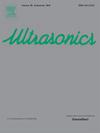利用超声纵波准静态分量对高密度聚乙烯进行SAFT成像。
IF 3.8
2区 物理与天体物理
Q1 ACOUSTICS
引用次数: 0
摘要
高密度聚乙烯(HDPE)被广泛应用于包括核电在内的各个行业,主要是因为它的特殊性能。然而,由于高密度聚乙烯的显著厚度和高衰减性,传统的线性超声成像系统面临挑战。高频载波可以提供更好的成像分辨率,但也会遭受更高的声衰减,这限制了主纵波(PLW)的传播距离,并且难以检测厚hdpe中的缺陷。另一方面,尽管衰减较低,传播距离较长,但使用低频PLW进行缺陷检测在分辨率方面存在挑战。本文提出了一种利用高频基波传播过程中由于非线性效应而产生的准静态分量(QSC)对hdpe进行缺陷成像的方法。QSC由于其载波频率为零,具有低衰减的优点,可以在HDPE等高声注意介质中长距离传播。提出了一种结合QSC和合成孔径聚焦技术的非线性超声成像方法,用于hdpe的缺陷成像。在单缺陷和多缺陷的hdpe上进行了实验,验证了该方法的性能。为了进行比较,还提供了传统线性超声在高(2.5 MHz)和低(0.5 MHz)载频下的成像结果。结果表明,该方法对高声注意力介质中缺陷的成像性能优于传统的线性超声成像方法。本文章由计算机程序翻译,如有差异,请以英文原文为准。
SAFT imaging for high-density polyethylene using quasi-static components of ultrasonic longitudinal waves
High-density polyethylene (HDPE) is extensively utilized across various industries, including nuclear power, primarily for its exceptional properties. However, there are challenges with traditional linear ultrasound imaging systems due to the significant thicknesses and the highly attenuative of HDPE. High-frequency carrier waves can offer better imaging resolution but also suffer higher acoustic attenuation, which limits the propagation distance of primary longitudinal waves (PLW) and makes it difficult to detect defects within thick HDPEs. On the other hand, using low-frequency PLW for defect detection presents challenges in resolution despite lower attenuation and longer propagation distances. This study proposes a defect imaging method for HDPEs by using quasi-static components (QSC) generated along with high-frequency fundamental wave propagation because of the nonlinear effect. The QSC has the advantage of low attenuation because its carrier frequency is zero, which can propagate a long distance in a high acoustic attention medium like HDPE. A nonlinear ultrasonic imaging approach combining the QSC and synthetic aperture focusing technique is proposed for defect imaging in HDPEs. Experiments on HDPEs with single and multiple defects are conducted to verify the performance of the proposed method. For comparison, the imaging results using traditional linear ultrasounds with high (2.5 MHz) and low (0.5 MHz) carrier frequencies are also provided. The results show the proposed method has better imaging performance over traditional linear ultrasound imaging methods for defect defections in high acoustic attention medium.
求助全文
通过发布文献求助,成功后即可免费获取论文全文。
去求助
来源期刊

Ultrasonics
医学-核医学
CiteScore
7.60
自引率
19.00%
发文量
186
审稿时长
3.9 months
期刊介绍:
Ultrasonics is the only internationally established journal which covers the entire field of ultrasound research and technology and all its many applications. Ultrasonics contains a variety of sections to keep readers fully informed and up-to-date on the whole spectrum of research and development throughout the world. Ultrasonics publishes papers of exceptional quality and of relevance to both academia and industry. Manuscripts in which ultrasonics is a central issue and not simply an incidental tool or minor issue, are welcomed.
As well as top quality original research papers and review articles by world renowned experts, Ultrasonics also regularly features short communications, a calendar of forthcoming events and special issues dedicated to topical subjects.
 求助内容:
求助内容: 应助结果提醒方式:
应助结果提醒方式:


